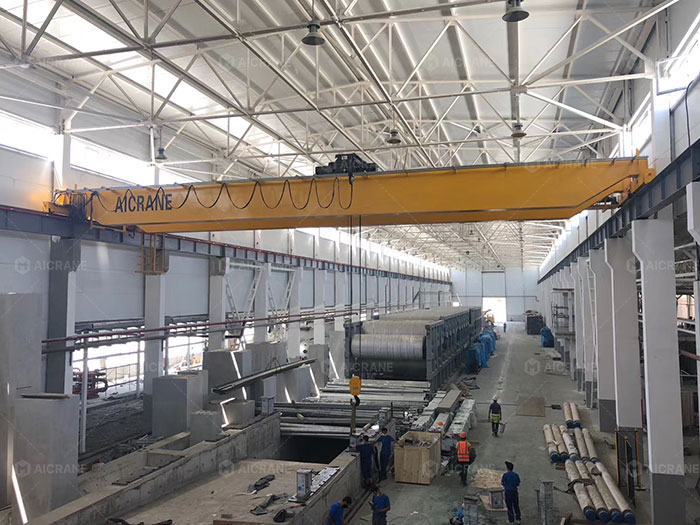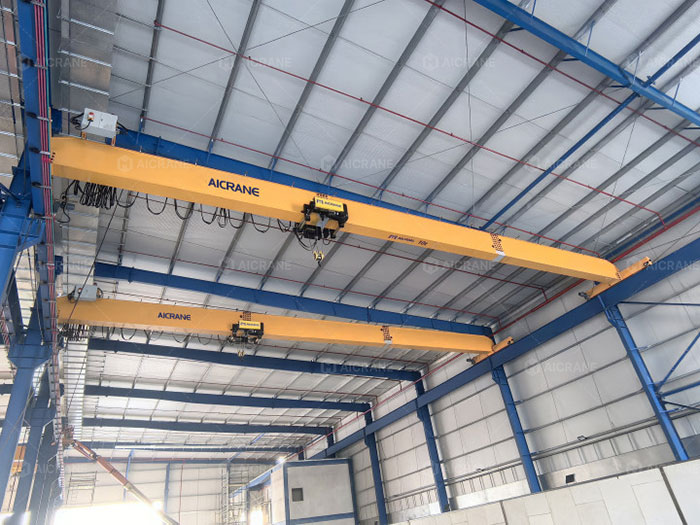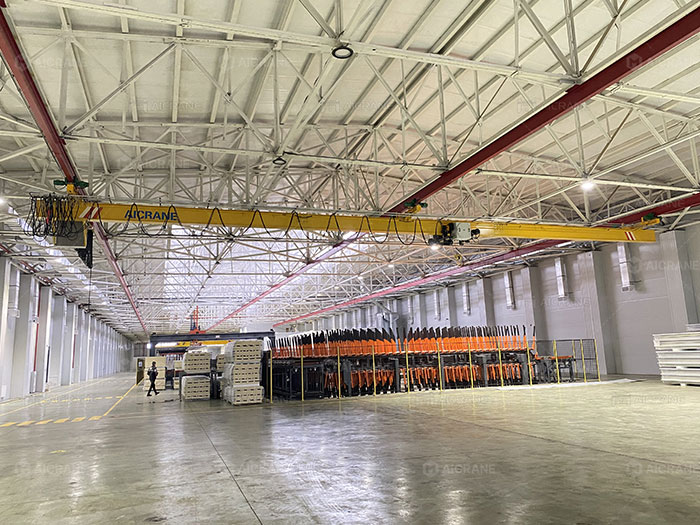In industrial settings, selecting the right type of overhead crane is critical for optimizing productivity, safety, and spatial efficiency. One of the most crucial yet often underestimated factors in this selection process is the building clear height – the vertical distance from the floor to the lowest overhead obstruction, such as the bottom of roof trusses, HVAC ducts, lighting systems, or existing equipment. Clear height plays a pivotal role in determining what type of overhead crane can be effectively used in a facility, as it directly impacts lifting height, operational safety, and the overall design of the crane system.
In this article, we will explore the importance of building clear height in overhead crane selection, how different types of cranes are affected, and what solutions are available when working in height-constrained environments.

Understanding Building Clear Height
What Is Clear Height?
Clear height is not the same as ceiling height. While ceiling height refers to the vertical distance to the underside of the roof structure, clear height is the actual usable vertical space available for operations. It takes into account any obstructions that may prevent the crane from utilizing the full ceiling height.
Why It Matters
In overhead crane systems, vertical space is essential for several reasons:
-
Lifting height requirements: How high a crane must lift and lower loads without interference.
-
Hoist headroom: The vertical distance from the hook in its highest position to the structure above it.
-
Safe operation: Adequate vertical clearance ensures safety by avoiding collisions with the building structure or suspended objects.
Types of Overhead Cranes and Their Height Requirements
There are several overhead crane configurations, and each interacts with building clear height differently. Choosing the wrong type could result in insufficient hook coverage, unsafe operations, or unnecessary structural modifications.
1. Top Running Single Girder Overhead Cranes
This type of single girder overhead crane runs on rails mounted on the top of runway beams. Because of its structural position, it typically offers more available lifting height than under running cranes but less than a double girder setup.
-
Clear height impact: Requires moderate vertical space.
-
Applications: Light to medium-duty lifting in facilities with decent overhead clearance.
-
Benefits: Lower cost, easier installation, less complex maintenance.

2. Top Running Double Girder Overhead Cranes
Top running double girder overhead cranes provide maximum lifting height, as the hoist is mounted on top of the bridge girders, effectively utilizing the full span between the floor and the building’s roof structure.
-
Clear height impact: Ideal for high-clearance buildings.
-
Applications: Heavy-duty operations where vertical space and hook height are critical.
-
Benefits: Greater hook height, higher capacity, wider span capabilities.
3. Under Running (Underslung) Cranes
Underslung cranes are suspended from the bottom of runway beams, which are typically attached directly to the building’s roof structure. These cranes usually provide less vertical clearance, as the beam and hoist hang below the runway.
-
Clear height impact: Suitable for buildings with limited headroom.
-
Applications: Lighter loads, short spans, smaller industrial facilities.
-
Benefits: Space-saving, no need for column supports, integration into tight spaces.

4. Low Headroom Hoists and Compact Crane Designs
In low-clearance buildings, specialized cranes such as low-headroom hoist designs or custom-engineered systems with compact profiles are critical.
-
Clear height impact: Minimized headroom maximizes usable lifting height.
-
Applications: Retrofits, confined industrial spaces, workshops.
-
Benefits: Efficient vertical space usage without modifying building structure.
Key Factors to Consider When Matching Crane Type with Clear Height
1. Hook Travel and Lift Height
The crane must be able to lift the load high enough to avoid obstructions and perform the necessary horizontal travel. If the building’s clear height is insufficient, certain crane types like double girder systems may be necessary to maximize lift height.
2. Headroom Requirements
Different crane types and hoists come with varying headroom profiles. Choosing a hoist with minimal headroom can make a significant difference in facilities with tight clearances.
3. Building Modifications
In cases where vertical clearance is severely limited, modifications such as roof raising, recessing the runway beams, or selecting an external gantry system might be considered – but these can be costly. Selecting a crane that fits the existing clear height is often the most economical solution.
4. Future Expansion Plans
If a business expects to scale operations, factoring in future lifting requirements may justify a crane with higher lifting capacity or hook height—even if that means investing in structural changes now.
Solutions for Low-Clearance Buildings
Low-clearance buildings pose a unique challenge but are not impossible to work with. Several options exist:
1. Low Headroom Wire Rope Hoists or Chain Hoists
Designed with a compact frame to reduce the total height, these hoists can be paired with both single and double girder cranes.
2. Custom-Built Underslung Cranes
If columns and runway beams reduce usable space, underslung cranes can be mounted directly to the existing structure without compromising floor space.
3. Recessed Runway Systems
By integrating the runway beams into the ceiling or roof structure, more vertical space can be preserved.
4. Wall-Mounted Jib Cranes or Monorails
In extremely tight environments where an overhead crane may not be feasible, alternative systems like wall-mounted cranes can still provide efficient material handling.
Case Example: Retrofitting a Crane in a Height-Constrained Facility
A client operating a 30-year-old fabrication workshop needed to install a new overhead crane system but was constrained by a clear height of only 5.5 meters due to low-hanging lighting and ventilation systems. Instead of redesigning the building or raising the roof, a low-headroom underslung crane system with an electric chain hoist was installed. This solution allowed the client to perform 5-ton lifts while avoiding expensive structural modifications and minimizing downtime.
Tips for Accurate Evaluation
-
Perform a Detailed Site Survey: Identify all overhead obstructions and accurately measure usable space.
-
Work with Crane Experts: Professional suppliers can propose multiple configurations tailored to your building dimensions.
-
Assess Long-Term Needs: Don’t focus solely on present limitations – plan for equipment growth or product changes.
Conclusion
Building clear height is one of the most important physical constraints that influence overhead crane type selection. Ignoring this factor can lead to costly retrofits, unsafe operations, or reduced crane functionality. By understanding how different overhead crane configurations interact with vertical space and taking a strategic approach to crane and hoist selection, businesses can maximize lifting performance while minimizing installation challenges.
Whether you’re outfitting a new facility or retrofitting an old one, clear height should always be a top priority during the crane planning and design process.
Need Help Choosing the Right Overhead Crane for Your Facility?
Contact our team today to discuss your building dimensions and lifting needs. We offer custom solutions for facilities with any clear height – from compact hoists for low-clearance workshops to heavy-duty double girder cranes for expansive industrial buildings. Let us help you design the most effective crane system for your operations.
